Catalogue: England
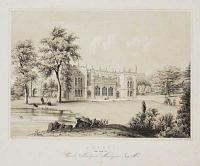
Arbury, The Seat of Charles Newdigate Newdegate, Esq.re M.P.
Drawn by I. Shaw. R. Groom, Lith.
C. Moody, Lith Printer, 257, Holborn. [n.d. c.1850.]
Rare tinted lithograph. Sheet size: 345 x 510mm (13½ x 20"), very large margins. Light spotting.
Arbury Hall, the seat of the Newdegate family and the ancestral home of Viscount and Vicountess Daventry, Warwickshire. It is an Elizabethan house, built on the site of a 12th century Augustinian Priory; it was then transformed in the 18th century to become the finest example of Gothic Revival architecture in the country, at the time.
[Ref: 40032] £160.00
(£192.00 incl.VAT)
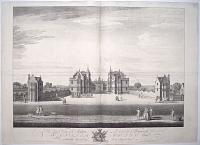
The East View of Aston in the County of Warwick, the Seat of S.r. Lister Holte, Bar.t is humbly Inscribed by his Obliged Serv.ts Sam.l & Nath.l Buck.
Sam.l & Nath.l Buck delin. et sculp. April 1744. 1 Garden Court Middle Temple.
Large engraving. 600 x 770mm (23½ x 30¼") with small margins. Several repairs, splits and tears.
A rare arial view of Aston Hall near Birmingham. Built in the Jacobean style by Sir Thomas Holte and completed 1635, the building passed into the possession of James Watt Jnr before becoming the first historic country house to pass into municipal ownership, 1864.
[Ref: 52627] £580.00

Aston Hall.
[c.1850.]
Tinted lithograph. Sheet 430 x 540mm, 17 x 14¼". Very trimmed, some damage, a rare survivor.
A rare arial view of Aston Hall near Birmingham. Built in the Jacobean style by Sir Thomas Holte and completed 1635, the building passed into the possession of James Watt Jnr before becoming the first historic country house to pass into municipal ownership, 1864.
[Ref: 18614] £160.00
(£192.00 incl.VAT)
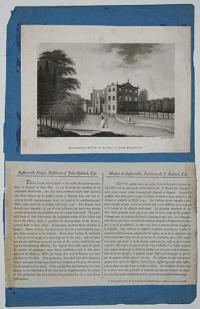
Baskerville House, the Residence of John Ryland Esq. Baskerville House, The Residence of John Ryland, Esq. This house, which stands in the midst of a luxuriant meadow, is situated on Easy Hill. It was formerly the dwelling of the celebrated Baskerville; but had been rendered much more spacious and more elegant by its present owner J. Ryland, Esq. and was receiving its last improvements, from the hand of its unoffending possessor, when attacked on Friday 15th July, 1791... Les habitants de cette ville et environs avec une générosité et humanité qui leur fait bonneur ont depuis levé une souscription considerable pour le soutien de cette famille malheureuse.
Drawn by P.H. Witton Jun.r Engraved by W.m Ellis.
[London. Published, 1 May 1792, by J.Johnson, St. Paul's Church Yard.]
Aquatint with descriptive text in English and French. Sheet 406 x 260mm. 16 x 10¼". Laid on album page, foxing.
The ruins of Baskerville House, belonging to John Ryland Esq. The crowd destroyed the home and drank the supplies of liquor which they found in the cellar. The Priestley Riots, the Birmingham Riots of 1791, targeted religious Dissenters, most notably the politically and theologically controversial Joseph Priestley. From "Views of the Ruins of the Principal Houses destroyed during the Riots at Birmingham. 1791." On the 14th of July, 1791, a party having met at an hotel to celebrate the anniversary of the French revolution, collected together as a mob, and proceeded for several days their devastations, setting fire to several meeting-houses and private mansions, but on the arrival of the military from Oxford and Hounslow, order was restored: at the ensuing assizes four of the ring-leaders were convicted, two of whom suffered the penalty of the law. Shortly after this occurrence barracks were erected on the Vauxhall-road, near the town, consisting of a range of handsome buildings, enclosing a spacious area for the exercise of cavalry, and a smaller for parades, a riding-school, a magazine, and an hospital.
[Ref: 21110] £140.00
(£168.00 incl.VAT)
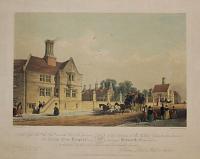
To the Right Hon.ble the Hon.ble and The Rev.d The Governors of the Hospital of Mr Nicholas Chamberlain; deceased This View of the New Hospital now erecting at Bedworth, Warwickshire, is dedicated by their most obedient and most humble Servant, Thomas Larkins Walker, Architect.
G. Hawkins, Jun.r lith. Day & Haghe, Lith.rs to the Queen.
[Published by Walker] 2, Kepple St, Russell Square, London, Sep.r 1839. N.B. Sold in aid of the funds for building an Infact School-House, on Bedworth Heath.
Tinted lithograph with hand colour. Printed area 285 x 340mm (11¼ x 13½"). Large margins.
A rare print of Bedworth Hospital, one of at least two published as fund-raisers for the Infant School. Bedford's current secondary school is named after the same Nicholas Chamberlaine (1632-1715). See Wellcome ICV No 12477 for the other lithograph.
[Ref: 38839] £220.00
(£264.00 incl.VAT)

Elevation. ['Birches Green/ occupied by Brueton Gibbins' in ink mss. below.]
Lithographic illustration to the sale particulars of the property [Birmingham, n.d., but 1848]. Thin paper, scarce Fold creases as normal; a little soiled, with slightly frayed extremities.
View of a substantial property in its grounds in the Erdington district of Birmingham; figures and a dog walking in the gardens. It was bought by Brueton Gibbins in 1819, a local business man and Quaker philanthropist who owned the Aston Glass and Flintworks. It was put up for sale by auction in 1848. The mansion was later known as 'Rookery House' and was purchased by the municipal council in the early 20th century to serve as a recreational park. Birmingham Archives & Heritage: Sales catalogues/Robins Vol 2, p.21.
[Ref: 24612] £130.00
(£156.00 incl.VAT)

The East Prospect of Birmingham, in the County of Warwick.
Sam.l & Nath.l Buck delin. et sculp. According to Act of Parliam.t May 26th 1753. Garden Court No 1. Middle Temple London [but published by Robert Sayer c.1774].
Coloured engraving. 315 x 820mm (12½ x 32¼").
A detailed prospect of Birmingham, with a 17-point key below. From the series 'Buck's Perspective Views of Cities and Chief Towns in England and Wales', as re-issued by Robert Sayer, with a plate number top right.
[Ref: 48186] £450.00
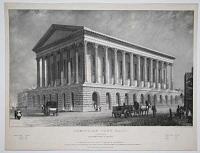
Birmingham Town Hall. now erecting by Hansom & Welch Archts. The Exterior of this Building is of Anglesey White Marble. It is intended to celebrate the next Musical Festival in this Building, in October 1833. The Hall for the purposes of Town's Meetings will contain upwards of 8000 persons.
Drawn On Stone By Henry Harris. Printed By C. Hullmandel.
Published March, 1832, by the Artist, Hagley Row, Edgbaston, Birmingham.
Lithograph on india laid paper, 355 x 470mm. 14 x 18½".
A handsome view of Birmingham Town Hall in Victoria Square, Birmingham. Joseph Hansom and Edward Welch were chosen as the architects. Construction began on April 27, 1832 with an expected completion date of 1833. However, Hansom went bankrupt during construction, having tendered too low. The contractors were also losing money. Three guarantors donated money for the building; W. P. Lloyd, John Welch and Edward Tench. With the injection of this money, the building was successfully opened for the delayed Birmingham Triennial Musical Festival on October 7, 1834, despite the building still being unfinished. During construction, on January 26, 1833, two workers were killed when a 70 foot crane constructed to install the roof trusses broke and the pulley block failed. Architect Charles Edge was commissioned in 1835 to repair weaknesses to the design of the building. He was also commissioned for the extension of the building in 1837 and again in 1850.
[Ref: 9465] £220.00
(£264.00 incl.VAT)

The South West Prospect of Birmingham, in the County of Warwick.
S. & N. Buck delin. et sculp.t 1731.
Engraving. Plate: 305 x 800mm (12 x 31½"). Central fold as issued, old ink mss. plate number. Slight offsetting in top title.
A detailed prospect of Birmingham, with a descriptive text below and a key to the right. From the series 'Buck's Perspective Views of Cities and Chief Towns in England and Wales'; an early printing, before the addition of a plate number top right.
[Ref: 46949] £480.00

Town of Birmingham.
John Kempson, Surveyor & Land Agent, Birmingham.
[Birmingham, c.1827.]
Engraved map. 420 x 300mm (16½ x 11¾"), watermarked 'J Whatman 1827'. Ink stain causing paper loss lower right, splits in folds.
A town plan of Birmingham with a table of Hackney-Coach Fares.
[Ref: 56097] £230.00

The Plan of Birmingham Survey'd in the Year 1731. To the Honourable Edw.d Digby & Will.m Peyto Esq:rs Members of Parliament for the County of Warwick, this Plate is humbly Dedicated by their most obed.t humble Serv:t W. Westley.
Copied from the Original Engraving and Published by Thomas Underwood, Castle St. High St. Birmingham [n.d., c.1860].
Engraved map. Printed area 400 x 490mm (15¾ x 19¼"), with large margins. Repaired tears.
A Victorian facsimiles of one the first detailed printed map of Birmingham, originally published the year that Samuel and Nathaniel Buck issued their prospect of the city. It names the streets and shows important buildings in perspective. The Corn Market next to St. Martin’s Church is now the Bull Ring. Underneath are statistics fot the city: in 1700 it contained 30 streets, 100 courts and alleys, 2,504 houses and 15032 inhabitants, but by 1730 there were 25 additional streets, 50 courts and alleys, 1252 houses and 8254 inhabitants, representing a doubling in size. William Westley, a local surveyor, owned land in the city's south-easst, commemorated with ‘Westley’s Row’.
[Ref: 59156] £280.00
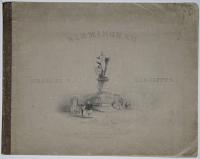
Views in Birmingham and its Vicinity, comprising Birmingham, from the London Railway, St. Philip's Church, King Edward's Grammar School, The Society of Arts and Town Hall, The Market Hall, High-Street and St. Martin's Church, Edgbaston Church, Handsworth Church.
Drawn and Lithographed by Charles Radclyffe.
Birmingham: Knott, Hawker, and Coburn [n.d., c.1845].
Book, oblong folio (330 x 415mm, 13 x 16¼") in original printed limp grey boards, vignette of Nelson's Monument to upper cover. Additional pictorial title page (from same stone), title and dedication leaf, followed by eight lithographic plates in sepia, complete as list. Description of views to rear of volume. Very scarce as complete book. Covers soiled and stained, bumped at extremities; some staining and foxing throughout.
A fine selection of views by Charles Walter Radclyffe (1817 - 1903). Abbey Scenery 49.
[Ref: 22517] £690.00
view all images for this item
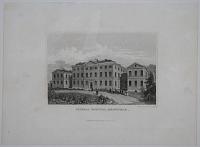
General Hospital, Birmingham.
Drawn & Engraved by T. Radclyffe.
Published by W. Emans Birmingham. [n.d. c.1830.]
Engraving. Plate 141 x 222mm. 5½ x 8¾".
The Birmingham General Hospital with the two side-wings as added in 1790. From 'A New and Compendious History of the County of Warwick, from the earliest period to the present time comprising views of the principal towns, buildings, modern improvements, seats of the nobility and gentry, ecclesiastical edifices, &c.' by William Smith, published, Birmingham 1830.
[Ref: 21894] £45.00
(£54.00 incl.VAT)
![[The Birmingham Hospitals Centre.]](img-thumbnail/jpegs/41344.jpg)
[The Birmingham Hospitals Centre.]
Stanley Anderson. [signature in pencil.]
[1938.]
Dry-point etching. Rare. Edition of 50. Framed. Plate: 345 x 230mm (13½ x 9"), Frame: 550 x 435mm (21¾ x 17"). Unexamined out of frame.
A view of the old Queen Elizabeth Hospital in Birmingham, designed by Thomas Arthur Lodge. The hospital was opened in 1939 by George VI and Queen Elizabeth after whom the hospital was named. The artist, Stanley Anderson (1884-1966) was famed for his detailed depictions of modern British life.
[Ref: 41344] £280.00
(£336.00 incl.VAT)
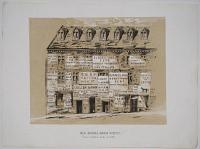
Old Houses, Moor Street.
From a Sketch made in 1866.
[n.d. c.1870.]
Tinted lithograph. 272 x 375mm. 10¾ x 14¾".
Bill boards and posters attached to the outside of an old building on Moor Street, Birmingham. Some read: "Dudley Castle Fete Monday and Tuesday May 27 and 28"; "Earp Tailor High St."; "Dr. Miller Lecture Love and Courtship"; Train to Hull"; Thorley's Food for Cattle"; Kirbys Pool Great Diving Feat Whit Monday"; and "Australian Curiosity Aston Road" - Australian interest. Plate from "Old Buildings of Birmingham".
[Ref: 21483] £130.00
(£156.00 incl.VAT)

Rocket Tavern & adjoining Premises as they appeared immediately after the Explosion.
Sketched & Drawn, on Stone by F. Lucas.
Printed & Published at T: Underwoods Lithographic Estab.t Cherry St. Birm.m [n.d. c.1825.]
Lithograph, very scarce. 380 x 488mm. 15 x 19¼".
Ruins of the Rocket Tavern in Birmingham following an explosion. Ex: Watt Collection.
[Ref: 21684] £280.00
(£336.00 incl.VAT)

Styles's Hotel. Temple Row, Birmingham.
T. Hollins del.t F. Eginton Sculp.t.
[n.d. c.1820.]
Aquatint. 195 x 254mm (7¾ x 10").
The Hotel as seen from the churchyard to St Philip's, Birmingham. Carriages and horses seen in the coach-house, stable and main road. In 1858 the hotel was renamed and became the Royal Hotel.
[Ref: 21604] £130.00
(£156.00 incl.VAT)
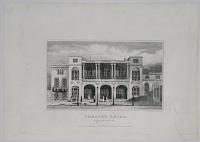
Theatre Royal, Birmingham.
Drawn & Engraved by T. Radclyffe.
Published by W. Emans, Sep.r 12.th 1829, Bromsgrove St. Birmingham.
Engraving. Plate 146 x 228mm (5¾ x 9"). Repaired tear bottom right off image.
The 1820 rebuilt, Theatre Royal, New Street, Birmingham, with the 1780 Samuel Wyatt facade still in place. This third theatre on the same site was designed by the architect Samuel Beazley, who designed and replaced everything behind the facade, which had remarkably survived the second fire as well as the first. From 'A New and Compendious History of the County of Warwick, from the earliest period to the present time comprising views of the principal towns, buildings, modern improvements, seats of the nobility and gentry, ecclesiastical edifices, &c.' by William Smith, published, Birmingham 1830.
[Ref: 21895] £45.00
(£54.00 incl.VAT)

Torque Field House.
R.B. Moody Lithog 12, Cannon St. Birmingham [n.d., c.1840s].
Rare lithograph. 190 x 265mm. 7½ x 10½". Cut.
View of the front elevation of a (fairly new) house, with walled garden in front; a gentleman on horseback with dogs and a drover herding cattle to foreground. Robert Boucher Moody was trading as a lithographic printer in Birmingham 1834 - 1868. See University of Birmingham British Book Trade Index.
[Ref: 24049] £85.00
(£102.00 incl.VAT)
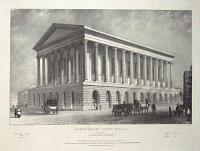
Birmingham Town Hall. now erecting by Hansom & Welch Arch.ts. The Exterior of this Building is of Anglesey White Marble. It is intended to celebrate the next Musical Festival in this Building, in October 1833. The Hall for the purposes of Town's Meetings will contain upwards of 8000 persons.
Drawn On Stone By Henry Harris. Printed By C. Hullmandel.
Published March, 1832, by the Artist, Hagley Row, Edgbaston, Birmingham.
Lithograph on chine collé. 355 x 470mm (14 x 18½"), with large margins. Repaired tears in margins.
A handsome view of Birmingham Town Hall in Victoria Square, Birmingham. Joseph Hansom and Edward Welch were chosen as the architects. Construction began on April 27, 1832 with an expected completion date of 1833. However, Hansom went bankrupt during construction, having tendered too low. The contractors were also losing money. Three guarantors donated money for the building; W. P. Lloyd, John Welch and Edward Tench. With the injection of this money, the building was successfully opened for the delayed Birmingham Triennial Musical Festival on October 7, 1834, despite the building still being unfinished. During construction, on January 26, 1833, two workers were killed when a 70 foot crane constructed to install the roof trusses broke and the pulley block failed. Architect Charles Edge was commissioned in 1835 to repair weaknesses to the design of the building. He was also commissioned for the extension of the building in 1837 and again in 1850.
[Ref: 59617] £360.00
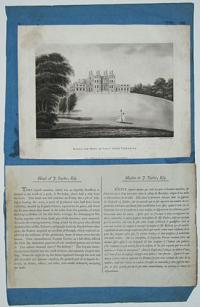
Bordesley Hall, the Seat of John Taylor, Esq. House of J. Taylor Esq. This superb mansion, which was as superbly finished, is situated in the midst of a park, at Bordesley, about half a mile from the town. This house was first attacked on Friday the 15th of July. Upon hearing the news, a party of gentlemen who had been sworn constables, headed by Captain Carver, repaired to the place, and drove the Rioters whom they found in the cellar from the premises, of which they kept possession till the title-deeds... ainsi fut réduite en cendres (excepté les murailles) cette superbe maison, la plus grande partie de son riche ameublement, les écuries, et toutes les dépendances.
Drawn by P.H. Witton Jun.r Engraved by W.m Ellis.
London. Published, 1 May 1792, by J.Johnson, St. Paul's Church Yard.
Aquatint with descriptive text in English and French. Sheet 406 x 260mm. 16 x 10¼". Laid on album page, foxing.
Bordesley Hall, the second property of John Taylor, and was burnt down during the Priestley Riots, the Birmingham Riots of 1791, which targeted religious Dissenters, most notably the politically and theologically controversial Joseph Priestley. From "Views of the Ruins of the Principal Houses destroyed during the Riots at Birmingham. 1791." On the 14th of July, 1791, a party having met at an hotel to celebrate the anniversary of the French revolution, collected together as a mob, and proceeded for several days their devastations, setting fire to several meeting-houses and private mansions, but on the arrival of the military from Oxford and Hounslow, order was restored: at the ensuing assizes four of the ring-leaders were convicted, two of whom suffered the penalty of the law. Shortly after this occurrence barracks were erected on the Vauxhall-road, near the town, consisting of a range of handsome buildings, enclosing a spacious area for the exercise of cavalry, and a smaller for parades, a riding-school, a magazine, and an hospital.
[Ref: 21112] £140.00
(£168.00 incl.VAT)

The South Prospect of the City of Coventry, in Warwickshire.
S. & N. Buck delin. et Sculp.t 1732.
Engraving. Plate: 305 x 800mm (12 x 31½"). Central fold as issued, old ink mss. plate number. Slight offsetting in title at top.
A detailed prospect of Coventry, with a descriptive text below and a key to the right. From the series 'Buck's Perspective Views of Cities and Chief Towns in England and Wales'; an early printing, before the addition of a plate number top right.
[Ref: 46970] £420.00
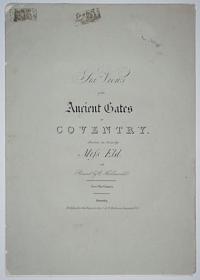
Six Views of the Ancient Gates of Coventry. Drawn on Stone by Miss Eld, and Printed by C. Hullmandel. Price One Guinea. Gosford Gate, Coventry. Taken down about 1760. [&] Mill Lane Gate, Coventry. [&] Spon Gate, Coventry. Taken down 1770. [&] Grey Friars Gate, Coventry. Taken down 1781. [&] Stanswell Gate, Coventry. [&] Cook Street Gate, Coventry.
S.E. del.t / S.E. del et lithog. Printed by C. Hullmandel.
Coventry. Published for the Proprietor by C.A.N. Rollason, January 1840.
Six tinted lithographs in wrapper. Rare. Sheet 500 x 354mm. 19¾ x 14".
Not in Abbey.
[Ref: 19694] £380.00
view all images for this item

Coventry Cross.
J. Seago sculp.
Sold by I: Seago Printseller High Street St. Giles's London. Where may be had great choice of Topographical and other prints.
Engraving. Plate: 430 x 190mm (17 x 7½"), with large margins. Light foxing.
A view of Coventry Cross built in 1539 in the centre of Coventry, the cross was removed bit by bit between 1750 and 1780 as it was deemed unsafe.
[Ref: 45400] £70.00
(£84.00 incl.VAT)
![Tottenham High Cross. [&] Coventry Cross.](img-thumbnail/jpegs/45408.jpg)
Tottenham High Cross. [&] Coventry Cross.
Publish'd Oct.r 29th 1787 by J. Seago, Printseller High Street, St Giles, London.
Pair of engravings on one sheet. Plates: 185 x 120mm (7¼ x 4¾) and 210 x 185mm (8¼ x 7¼"), with large margins.
A pair of engravings showing medieval crosses, the first is Tottenham High Cross built in around 1609, the image shows it in its plain form before it was ornamented in 1809. The second cross is Coventry cross which was pulled apart bit by bit between 1750 and 1780 as it was deemed unsafe.
[Ref: 45408] £70.00
(£84.00 incl.VAT)
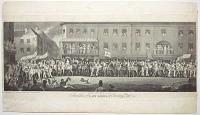
Procession of Lady Godiva, at Coventry Fair.
Engraved by M.U. Sears I Warwick Sq.r Paternoster Row.
Published by Henry Merridew, Coventry [n.d., c.1840.]
Scarce engraving on chiné collé. 180 x 400mm (7 x 15¾"). Trimmed at sides.
A locally published view of the annual Coventry Great Fair, with a local beauty recreating Lady Godiva's famous ride, but not quite naked. The Godiva Procession was first recorded in 1678. It has survived several attempts to suppress it.
[Ref: 57626] £260.00
(£312.00 incl.VAT)
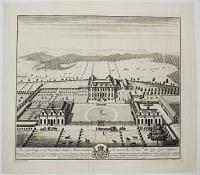
The East Prospect of Four Oaks Hall in Warwickshire, the seat of the R.t Hon.ble the late Lord Folliot.
Hen. Beighton F.R.S. delin. E. Kirkall Fecit.
[London: John Osborn & Thomas Longman, 1730.]
Engraving. 365 x 410mm (14½ x 16"), with very large margins.
Four Oaks Hall, Sutton Coldfield, built by Henry Folliott, 1st Baron Folliott, in 1677, demolished 1898. Four Oaks Park is now a wealthy residential area.
[Ref: 49816] £380.00
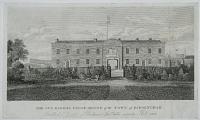
The Gun-Barrel Proof-House of the Town of Birmingham. Established by Act of Parliament for Public security, A.D. 1813.
Rock.
[n.d. c.1814.]
Engraving. Image 170 x 285mm. 6¾ x 11¼".
The Birmingham Gun Barrel Proof House was established in 1813 by an act of Parliament at the request, and expense, of the then prosperous Birmingham Gun Trade. Its remit was to provide a testing and certification service for firearms; such testing prior to sale was made mandatory under the Gun Barrel Proof Act of 1868. The Jacobean-style building was designed by John Horton.
[Ref: 21118] £120.00
(£144.00 incl.VAT)

The House of George Humphrys Esq. Spark Brook. House of G. Humphrys, Esq. This house, which was of brick and stone, was one of the most elegant and completely finished in the vicinity of Birmingham. It is situated at a place called Spark-Brook, about a mile from the town. On the morning of Saturday July 16th, 1791, a large concourse of people assembled on the turnpike-road, and in the pleasure-grounds which surround the house. Between the hours of eleven and twelve they began the attack... en les declarant des morceaux achevés et des plus rares, ouvrages qui furent cependant sacrifiés à la fureur d’une populace égarée et abrutie.
Drawn by P.H. Witton Jun.r Engraved by W.m Ellis.
[London. Published, 1 May 1792, by J.Johnson, St. Paul's Church Yard.]
Aquatint with descriptive text in English and French. Sheet 406 x 260mm. 16 x 10¼". Laid on album page, foxing.
George Humphrys's house following its destruction during the Priestley Riots, the Birmingham Riots of 1791, which targeted religious Dissenters, most notably the politically and theologically controversial Joseph Priestley. On 16th July 1791, rioters attacked the homes and properties of known Dissenters and religious preachers. From "Views of the Ruins of the Principal Houses destroyed during the Riots at Birmingham. 1791." On the 14th of July, 1791, a party having met at an hotel to celebrate the anniversary of the French revolution, collected together as a mob, and proceeded for several days their devastations, setting fire to several meeting-houses and private mansions, but on the arrival of the military from Oxford and Hounslow, order was restored: at the ensuing assizes four of the ring-leaders were convicted, two of whom suffered the penalty of the law. Shortly after this occurrence barracks were erected on the Vauxhall-road, near the town, consisting of a range of handsome buildings, enclosing a spacious area for the exercise of cavalry, and a smaller for parades, a riding-school, a magazine, and an hospital.
[Ref: 21107] £140.00
(£168.00 incl.VAT)
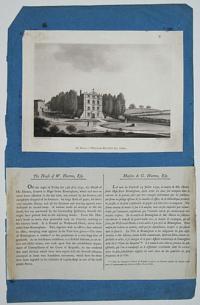
The House of William Hutton Esq. Saltley. The House of W. Hutton, Esq. On the night of Friday 15th July 1791, the House Mr. Hutton, situated n High-Street, Birmingham, which had once or twice been assaulted in the day time, was entered by the Rioters, and completely stripped of its furniture: his large stock of paper, his Son’s very valuable library, and all his furniture and wearing apparel, were destroyed or carried away... Il a rendu à cette ville les services les plus essentiels, qui l’en a recompensé en le diffamant cruellement dans les caricatures les plus scandaleuses exposées en vente dans un des quartiers les plus frequentés de la Ville.
Drawn by P.H. Witton Jun.r Engraved by W.m Ellis.
[London. Published, 1 May 1792, by J.Johnson, St. Paul's Church Yard.]
Aquatint with descriptive text in English and French. Sheet 406 x 260mm. 16 x 10¼". Laid on album page, foxing.
William Hutton (1723-1815) was a poet and the first significant historian of Birmingham. He was a Unitarian nonconfromist and both his houses were destroyed during the riots on 15th July 1791. The Priestley Riots, the Birmingham Riots of 1791, targeted religious Dissenters, most notably the politically and theologically controversial Joseph Priestley. From "Views of the Ruins of the Principal Houses destroyed during the Riots at Birmingham. 1791". On the 14th of July, 1791, a party having met at an hotel to celebrate the anniversary of the French revolution, collected together as a mob, and proceeded for several days their devastations, setting fire to several meeting-houses and private mansions, but on the arrival of the military from Oxford and Hounslow, order was restored: at the ensuing assizes four of the ring-leaders were convicted, two of whom suffered the penalty of the law. Shortly after this occurrence barracks were erected on the Vauxhall-road, near the town, consisting of a range of handsome buildings, enclosing a spacious area for the exercise of cavalry, and a smaller for parades, a riding-school, a magazine, and an hospital.
[Ref: 21109] £140.00
(£168.00 incl.VAT)
![[Kenilworth Castle.] 21.](img-thumbnail/jpegs/14609.jpg)
[Kenilworth Castle.] 21. [The Castle was built in 1122 by Geoffrey de Clinton, Chamberlain to Henry I. In the reign of King John, the Castle reverted to the Crown, the King paid several visits to it and he is believed to have constructed Lunn's Tower in the western corner. The Castle played an important part in the history of this country, and is associated with Simon de Montfort, the father of the British Parliament, and with Queen Elizabeth who was sumptuously entertained there by her favourite, Robert Dudley, the Earl of Leicester. These entertainments were of times most fantastic and extravegant, and one costing Leicester £1,000 a day is reported to have lasted seventeen days. Sir Walter Scott has made Kenilworth almost as famour as Shakespeare did Stratford. It is thought likely that Shakespeare when a boy may have travelled to Kenilworth to see some of the gorgeous entertainments given by the Earl of Leiciester, and that in "Midsummer Night's Dream" he re-produced his youthful impressions.]
Arthur Spencer [pencil signature to the bottom left-hand side outside the image]
[n.d. c.1920.] Copyright. F. & M. Ltd., Bedford, Eng.
Etching. 257 x 288mm. 10 x 11¼".
[Ref: 14609] £30.00
(£36.00 incl.VAT)
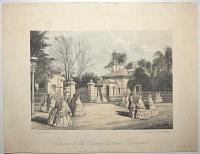
Entrance to the Jephson Gardens, Leamington.
J.A. Spencer, Photo. John Lane & Co Lith. London.
London, Published for the Proprietors by Kelly & C.o. [n.d., c.1850.]
Rare tinted lithograph. Sheet Sheet 215 x 280mm (8½ x 11").
A view of the Lodge Entrance to Jephson Gardens, a formal gardens in Leamington Spa.
[Ref: 60792] £140.00
(£168.00 incl.VAT)
![[In ink:] The Regents Hotel Leamington.](img-thumbnail/jpegs/19111.jpg)
[In ink:] The Regents Hotel Leamington.
[n.d. c.1860.]
Engraving. 90 x 121mm. 3½ x 4¾".
South and West views of the Regent Hotel Royal, Leamington Spa. In 1849 another Parade entrance was added to the west side. Queen Victoria stated at the Regent Hotel when she visited Leamington Spa in 1830.
[Ref: 19111] £35.00
(£42.00 incl.VAT)
![[Memorial Theatre, Stratford-on-Avon.] 25.](img-thumbnail/jpegs/14613.jpg)
[Memorial Theatre, Stratford-on-Avon.] 25. [The original Shakespeare memorial, consisting of a theatre, picture gallery and library, built in 1877, was largely destroyed by fire in 1926. At the request of the governors, the Royal Institute of British Architects instituted a competition to open to architects in the British Isles, Canada and the United States of America. The plan chosen was that of Miss Elizabeth Scott, and the new building was opened in April, 1932. It is a brick building of bolds, rather severe, outlings, standing in an unrivalled position on the bank of the Avon. The shell of the old theatre was converted into a fine Conference Hall seating between four and five hundred persons. The theatre is elaborately equipped to ensure the same continuity of scenes as the plays had in Shakespeare's day. Every year the theatre presents a festival of plays both by Shakespeare and other playwrights.]
Arthur Spencer [pencil signature to the bottom left-hand side outside the image]
[n.d. c.1920.] Copyright. F. & M. Ltd., Bedford, Eng.
Etching. 257 x 280mm. 10 x 11".
[Ref: 14613] £60.00
(£72.00 incl.VAT)

Moseley Hall, the Residence of Lady Carhampton. Moseley-Hall, Residence of Lady Carhampton. Moseley-Hall is situated on a rising ground, in the village of that name, about three miles from Birmingham. This was next to Mr Russell’s in the order of destruction... c’est a quoi elle se trouva obligée de se conformer, et le Samedi soi 16 Juillet cette belle maison devint la proie des flammes.
Drawn by P.H. Witton Jun.r Engraved by W.m Ellis.
London. Published, 1 May 1792, by J.Johnson, St. Paul's Church Yard.
Aquatint with descriptive text in English and French. Sheet 406 x 260mm. 16 x 10¼". Laid on album page, foxing.
Moseley Hall, belonged to John Taylor, and was burnt down after the rioters had carefully moved all the furniture and belongings of the occupant, the Dowager Lady Carhampton, a relative of George III . The Priestley Riots, the Birmingham Riots of 1791, targeted religious Dissenters, most notably the politically and theologically controversial Joseph Priestley. From "Views of the Ruins of the Principal Houses destroyed during the Riots at Birmingham. 1791." On the 14th of July, 1791, a party having met at an hotel to celebrate the anniversary of the French revolution, collected together as a mob, and proceeded for several days their devastations, setting fire to several meeting-houses and private mansions, but on the arrival of the military from Oxford and Hounslow, order was restored: at the ensuing assizes four of the ring-leaders were convicted, two of whom suffered the penalty of the law. Shortly after this occurrence barracks were erected on the Vauxhall-road, near the town, consisting of a range of handsome buildings, enclosing a spacious area for the exercise of cavalry, and a smaller for parades, a riding-school, a magazine, and an hospital.
[Ref: 21111] £140.00
(£168.00 incl.VAT)
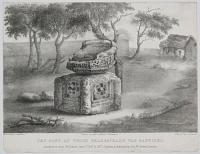
The Font at Which Shakespeare was Baptized.
Drawn by Mrs. P. Dighton. Printed by Lefevre & Kohler. 51, Newman St. Lithog.d by J. Salmon.
Stratford on Avon: Published June 1.st 1835 by Mrs. P. Dighton, & Ackermann & Co, 96 Strand London.
A very rare lithograph. 190 x 248mm (7½ x 9¾"). Cut.
The font is held at the Church of the Holy Trinity, Stratford-upon-Avon; also known as Shakespeare's church due to its fame as the place of baptism and burial of William Shakespeare.
[Ref: 30845] £65.00
(£78.00 incl.VAT)
![[Shakespeare's Birthplace.]](img-thumbnail/jpegs/27383.jpg)
[Shakespeare's Birthplace.]
W H Sweet [pencil signature.]
[British, n.d. c.1920.]
Etching, 170 x 270mm. 6¾ x 10½".
Shakespeare's Birthplace is a restored 16th-century half-timbered house in Henley Street, Stratford-upon-Avon, Warwickshire, where it is believed that William Shakespeare was born in 1564 and spent his childhood years. It is now a small museum open to the public and a popular visitor attraction, owned and managed by the Shakespeare Birthplace Trust. Walter Henry Sweet (1889-1943), prolific Devon artist who painted street scenes, moorland views and seascapes. With Fine Art Trade Guild blindstamp to lower margin.
[Ref: 27383] £95.00
(£114.00 incl.VAT)
![[Anne Hathway's Cottage. Stratford-on-Avon.] 17.](img-thumbnail/jpegs/14605.jpg)
[Anne Hathway's Cottage. Stratford-on-Avon.] 17. [Anne Hathaway's Cottage, in the village of Shottery, one mile from Shakespeare's Birthplace, was the early home of Shakespeare's wife and of her family. The property was in the Hathaway family from the time of Henry VIII. to 1838. It is a thatched cottage of the Elizabethan period, and is preserved with much furniture of corresponding date. No building in England is more famous than this "humble" cottage, and no place excepting Shakespeare's Birthplace has more visitors. The cottage, or house, is furnished in a homely style. In one room is the famous courting settle beside the hearth, where it would be well in view of the parents sitting at either end of the chimney corner. The house is of interest as a typical thatched Elizabethan farmstead, but it is its association with Shakespeare that has made it a centre of attraction for visitors to Stratford.]
Arthur Spencer [pencil signature to the bottom left-hand side outside the image]
[n.d. c.1920.] Copyright. F. & M. Ltd., Bedford, Eng.
Etching. 256 x 285mm.
[Ref: 14605] £40.00
(£48.00 incl.VAT)
![[Anne Hathway's Cottage. Stratford-on-Avon]](img-thumbnail/jpegs/60418.jpg)
[Anne Hathway's Cottage. Stratford-on-Avon]
W H Sweet [pencil signature.]
[British, n.d. c.1920.]
Etching, 175 x 275mm (7 x 10¾"), with large margins. With Fine Art Trade Guild blindstamp to lower margin.
Anne Hathaway's Cottage, in the village of Shottery, one mile from Shakespeare's Birthplace, was the early home of Shakespeare's wife and of her family. The property was in the Hathaway family from the time of Henry VIII to 1838. It is a thatched cottage of the Elizabethan period, and is preserved with much furniture of corresponding date. No building in England is more famous than this "humble" cottage, and no place excepting Shakespeare's Birthplace has more visitors. The cottage, or house, is furnished in a homely style. In one room is the famous courting settle beside the hearth, where it would be well in view of the parents sitting at either end of the chimney corner. The house is of interest as a typical thatched Elizabethan farmstead, but it is its association with Shakespeare that has made it a centre of attraction for visitors to Stratford. Walter Henry Sweet (1889-1943), prolific Devon artist who painted street scenes, moorland views and seascapes.
[Ref: 60418] £90.00
(£108.00 incl.VAT)

Stratford upon Avon. The grave of Shakespeare is situated between the windows seen in the church. ''His good remembrance lies richer in your thoughts, than on his tomb.''
G.F. Robson del.t. W.J. Bennett sculp.t.
London Published Jan.y 20, 1822, by S. & I. Fuller, at the Temple of Fancy, 34 Rathbone Place.
Aquatint, rare. Sheet: 500 x 400mm (19¾ x 15¾"). Trimmed within plate. Marking in margins.
A moonlit scene in looking up the Avon to the church at Stratford-upon-Avon where William Shakespeare is buried. He died on 23rd April 1616.
[Ref: 44880] £350.00

Stratford on Avon. The Home of Shakspeare [sic].
Published by Rock & Co. London. [c.1865.]
Attractive souvenir booklet of six steel engraved views, oblong 12mo, stitched into original printed card wrappers; embossed upper cover. Binding scuffed and rubbed, upper cover with large chip.
No text save captions; all plates numbered, five dated.
[Ref: 18574] £90.00
view all images for this item

The House at Stratford on Avon, in which Shakespeare was born.
Drawn on Stone by N. Whittock Oxford. Printed by Redman, London.
[n.d., c.1820.]
Lithograph. 241 x 171mm (9½ x 6¾"), with good margins.
The 16th-century half-timbered house on Henley Street, Stratford-upon-Avon, Warwickshire, believed to be William Shakespeare's birth place. An early British lithograph. David J. Redman was a former employee of Georg Johann Vollweiler, who sold the secret of lithography to Colonel John Brown in 1807. Redman's plan of Bantry Bay of 1808 is the earliest known lithographic map.
[Ref: 31023] £60.00
(£72.00 incl.VAT)
![[Harvard House.] 22.](img-thumbnail/jpegs/14610.jpg)
[Harvard House.] 22. [Harvard House in the High Street of Stratford-on-Avon was the home of Katherine Rogers, afterwards Harvard, the founder of the American University of that name. It was carefully restored in 1909. Beneath the front window are inscribed the initials of Thomas and Alice Roger, parents of Katherine Rogers. Apart from its associations for Americans, the house is remarkable as a very fine and ornate example of late Elizabethan timber-work, anticipating the style known as Jacobean. The entire front is covered with a profusion of carved ornament, to such an extent that little of the timber frame has been left plain. Above the bracket heads on the ground floor is the carving of a female head, somewhat mutilated, and possibly intended to be Queen Elizabeth. Other parts of the house are of later date, a fire in 1595 having destroyed parts of it. The upstairs parlous is notable for beautiful oak panelling and for its period furniture.]
Arthur Spencer [pencil signature to the bottom left-hand side outside the image]
[n.d. c.1920.] Copyright. F. & M. Ltd., Bedford, Eng.
Etching. 285 x 252mm. 11¼ x 10".
[Ref: 14610] £75.00
(£90.00 incl.VAT)
![[Anne Hathaway's Cottage.] The Cottage at Shottery, near Stratford-Upon-Avon,](img-thumbnail/jpegs/61089.jpg)
[Anne Hathaway's Cottage.] The Cottage at Shottery, near Stratford-Upon-Avon, Where Shakespeare wooed and won his wife, Anne Hathaway; Whose Name Has Suggested the Following Exquisite Jeu de Mots.
[n.d., c.1840.]
Broadside, woodcut and letterpress on blue paper. Sheet 250 x 200mm (9¾ x 8"). Small stain at top edge, corners chipped.
A flyer for visitors to Anne Hathaway's cottage. The 'Jeu de Mots' is a pun on Anne's name, ''Anne hath a way'.
[Ref: 61089] £95.00
(£114.00 incl.VAT)

The Prospect of Tamworth from Colshill Roade on the North thereof.
[Wenceslaus Hollar.]
[n.d., c.1730.]
Etching. Sheet 65 x 185mm (2½ x 7¼"), with letterpress on reverse. Trimmed to image, laid on album paper.
A view of the town behind trees, with the church and castle. From Dugdale's 'Antiquities of Warwickshire', first published 1656. Pennington lists two editions with letterpress on verso, 1730 & 1765. Pennington 1065.
[Ref: 60813] £160.00
(£192.00 incl.VAT)
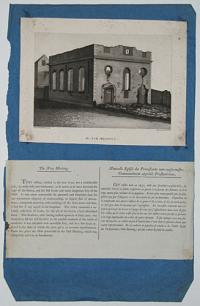
The New Meeting. The New Meeting. This edifice, erected in the year 1730, was a considerable pile; its walls lofty and substantial; in so much as to have survived the rage of the flames, and the still fiercer and more dangerous fury of the Mob... De cet endroit la populace se rendit à la Vieille Eglise des Prebytétiens (Old Meeting) qui fut ruinée de fond en comble.
Drawn by P.H. Witton Jun.r Engraved by W.m Ellis.
[London. Published, 1 May 1792, by J.Johnson, St. Paul's Church Yard.]
Aquatint with descriptive text in English and French. Sheet 406 x 260mm. 16 x 10¼". Laid on album page, foxing.
The New Meeting Chapel following its destruction during the Priestley Riots, the Birmingham Riots of 1791, which targeted religious Dissenters, most notably the politically and theologically controversial Joseph Priestley. On 14th July 1791, rioters approached the Quaker House until it was decided that the Quakers never troubled themselves with anything, and thus convinced themselves to attack the New Meeting Chapel, where Priestley presided as minister. From "Views of the Ruins of the Principal Houses destroyed during the Riots at Birmingham. 1791." On the 14th of July, 1791, a party having met at an hotel to celebrate the anniversary of the French revolution, collected together as a mob, and proceeded for several days their devastations, setting fire to several meeting-houses and private mansions, but on the arrival of the military from Oxford and Hounslow, order was restored: at the ensuing assizes four of the ring-leaders were convicted, two of whom suffered the penalty of the law. Shortly after this occurrence barracks were erected on the Vauxhall-road, near the town, consisting of a range of handsome buildings, enclosing a spacious area for the exercise of cavalry, and a smaller for parades, a riding-school, a magazine, and an hospital.
[Ref: 21105] £140.00
(£168.00 incl.VAT)
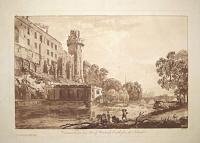
Caesars Tower and Part of Warwick Castle from the Island.
P. Sandby Fecit.
Publish'd Jany. 1776. by J Boydell Cheapside.
Aquatint printed in sepia. 320 x 375mm (12½ x 14¾"), with large margins..
A view of Warwick Castle, looking up at the walls from an island in the Avon, from a set of four views of Warwick that Sandby dedicated to his pupil Charles Greville. Ex Collection of Sarah Baynton-Williams.
[Ref: 55985] £550.00
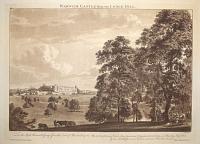
Warwick Castle from the Lodge Hill. To the Right Honourable George Greville Earl of Warwick &c. &c. This and the following Views of his Ancient and Magnificent Castle, are Humbly Inscribed, by his Lordships most Obedient and most Humble Servant Paul Sandby R. A.
P. Sandby Fecit.
Publish'd Jany. 1776. by J Boydell Cheapside.
Aquatint, printed in sepia, 18th century watermark; 335 x 475mm (13¼ x 18¾"), with very large margins. Repaired tear in margin, creasing.
The first plate of four views of Warwick by Paul Sandby (1725 - 1809), dedicated to his pupil Charles Greville, who gave the secret of the aquatint method to Sandby. Ex Collection of Sarah Baynton-Williams.
[Ref: 55982] £360.00
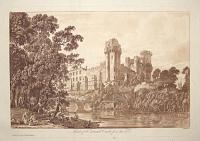
Part of Warwick Castle from the S.E.
P. Sandby Fecit.
Publish'd Jany. 1776. by J Boydell Cheapside.
Aquatint printed in sepia, 18th century watermark; 320 x 375mm (12½ x 14¾"), with very large margins.. Creasing.
A view of Warwick Castle, looking up at the walls from the banks of the Avon, from a set of four views of Warwick that Sandby dedicated to his pupil Charles Greville. Ex Collection of Sarah Baynton-Williams.
[Ref: 55984] £330.00
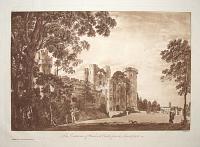
The Entrance of Warwick Castle from the Lower Court.
P. Sandby Fecit.
Publish'd Jany. 1776. by J. Boydell Cheapside.
Aquatint, printed in sepia. 345 x 480mm (13½ x 18¾"), with very large margins. Long printer's crease in image on left.
A view of the walls of Warwick Castle, plate two from a set of four by Paul Sandby (1725 - 1809). In the foreground a man tries to disentangle a kite from a tree. Ex Collection of Sarah Baynton-Williams.
[Ref: 55983] £360.00













![[The Birmingham Hospitals Centre.]](img-thumbnail/jpegs/41344.jpg)










![Tottenham High Cross. [&] Coventry Cross.](img-thumbnail/jpegs/45408.jpg)





![[Kenilworth Castle.] 21.](img-thumbnail/jpegs/14609.jpg)

![[In ink:] The Regents Hotel Leamington.](img-thumbnail/jpegs/19111.jpg)
![[Memorial Theatre, Stratford-on-Avon.] 25.](img-thumbnail/jpegs/14613.jpg)


![[Shakespeare's Birthplace.]](img-thumbnail/jpegs/27383.jpg)
![[Anne Hathway's Cottage. Stratford-on-Avon.] 17.](img-thumbnail/jpegs/14605.jpg)
![[Anne Hathway's Cottage. Stratford-on-Avon]](img-thumbnail/jpegs/60418.jpg)



![[Harvard House.] 22.](img-thumbnail/jpegs/14610.jpg)
![[Anne Hathaway's Cottage.] The Cottage at Shottery, near Stratford-Upon-Avon,](img-thumbnail/jpegs/61089.jpg)





